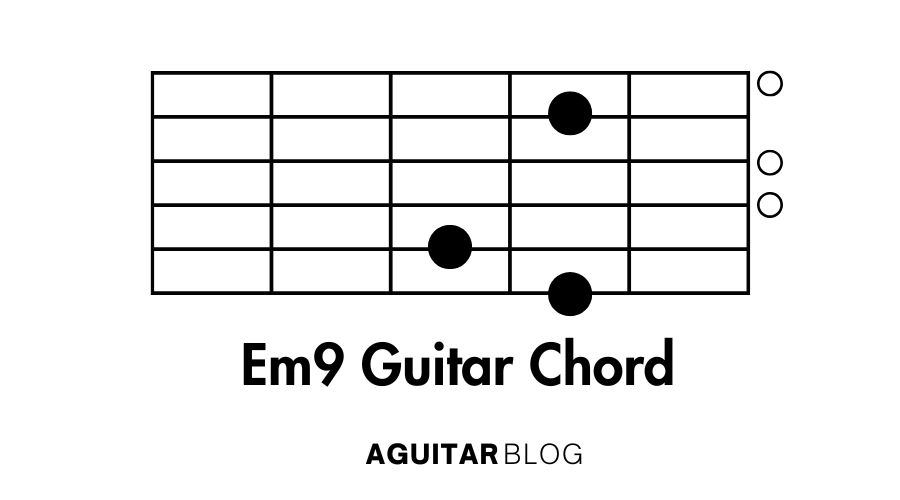The Em9 guitar chord (E minor ninth) is a beautiful, moody chord that combines the somber quality of a minor chord with the added richness of the ninth. It’s a versatile chord used in jazz, rock, blues, and even classical music, offering a lush and atmospheric sound that can bring an emotional depth to your playing.
1. What is an Em9 Guitar Chord?
The Em9 chord is an extension of the standard E minor chord. It adds a ninth (F#) on top of the minor triad (E, G, and B) and the minor seventh (D), creating a complex but harmonious sound. The combination of these notes gives the chord a mysterious, melancholic, and sometimes jazzy feel.
Em9 Chord Formula:
- Root (E)
- Minor third (G)
- Perfect fifth (B)
- Minor seventh (D)
- Major ninth (F#)
This adds color and depth to the typical E minor chord by blending both minor and major intervals.
2. How to Play the Em9 Guitar Chord

There are multiple ways to play the Em9 chord, ranging from simple open shapes to more advanced barre chords.
Em9 Open Position:
- Place your middle finger on the 2nd fret of the A string (5th string).
- Place your index finger on the 1st fret of the D string (4th string).
- Leave the G, B, and high E strings open.
- Strum from the low E string to the high E string.
This open shape is one of the easiest ways to play Em9, and it gives a rich, resonant sound with all open strings ringing out.
Em9 Barre Chord (7th Fret):
- Barre your index finger across all the strings at the 7th fret.
- Place your ring finger on the 9th fret of the A string (5th string).
- Place your pinky finger on the 9th fret of the D string (4th string).
- Strum from the low E string to the high E string.
This barre version of Em9 has a thicker, punchier sound and is perfect for more advanced players who want a solid minor ninth sound.
Strumming Tips:
- For a dreamy effect, use soft strumming or fingerpicking to allow the notes to ring out individually.
- Emphasize the higher notes (B and E strings) for a more atmospheric sound.
3. Video Tutorial
For visual learners, check out this Video Tutorial on the Em9 Guitar Chord. The tutorial will walk you through different shapes and transitions for the chord.
4. Common Mistakes and Tips for Playing the Em9 Guitar Chord
Common Mistakes:
- Muted strings: Make sure that all strings ring out clearly by positioning your fingers properly and pressing down firmly.
- Overstrumming: The Em9 chord sounds best when strummed gently, allowing each note to be heard clearly.
Tips for Playing the Em9 Chord:
- Practice slowly: Start by playing the chord one string at a time to ensure that every note rings out clearly before moving to full strums.
- Focus on smooth transitions: Em9 is commonly used in jazz or complex chord progressions, so practice switching between it and other chords, like Gmaj7 or A7.
- Use dynamics: Experiment with volume control when strumming or fingerpicking the chord to bring out its emotional depth.
5. Em9 Chord Variations
Here are some variations of the Em9 chord to explore:
- Em9 Barre Chord (12th Fret): You can play Em9 by barring the 12th fret for a higher-pitched, airy sound that works well in soft, dreamy sections of songs.
- Em7: Simplify the chord by removing the ninth and playing Em7, which still retains a minor, melancholic quality.
6. Chord Progressions and Songs Featuring the Em9 Guitar Chord
Common Chord Progressions:
- Em9 – A7 – Dmaj9: A jazz progression with a smooth, flowing sound.
- Em9 – Gmaj7 – Cmaj7 – Am7: A dreamy progression that works well for soft rock or ballads.
- Em9 – Dm7 – Cmaj9 – Bm7: A soulful chord progression used in R&B or jazz.
Songs Featuring the Em9 Chord:
- “The Wind Cries Mary” by Jimi Hendrix: Uses the Em9 chord to add depth to the ballad’s jazzy, soulful feel.
- “Little Wing” by Jimi Hendrix: Another classic that features Em9 in a soulful guitar melody.
- “Teardrop” by Massive Attack: Em9 is used to create a haunting, atmospheric sound in this song.
7. Tips for Practicing the Em9 Guitar Chord
- Practice fingerpicking: Em9 sounds great with fingerpicking techniques. Try arpeggiating the chord to bring out its harmonic complexity.
- Use a metronome: Start slow and gradually build up speed when practicing Em9 chord progressions.
- Experiment with effects: Adding reverb or delay can accentuate the atmospheric quality of the Em9 chord.
8. Related Chords to Em9 Guitar Chord
Here are some related chords that pair well with Em9:
- Gmaj7: A major seventh chord that pairs beautifully with Em9 in jazz or pop progressions.
- A7: A dominant seventh chord often used with Em9 in blues or jazz progressions.
- Cmaj9: Another ninth chord that complements Em9 in more advanced progressions.
The Em9 guitar chord is a must-know for any guitarist looking to add some emotional depth and complexity to their music. Whether you’re playing jazz, blues, or soft rock, the Em9 chord will bring a lush, melancholic sound to your progressions. Happy playing!